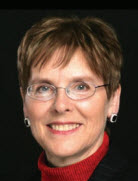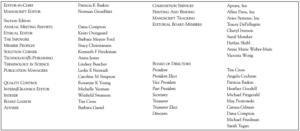
Editor-in-Chief, Science Editor
The 2014 annual meeting held in San Antonio has taken its place in CSE history, but the memories of sharing knowledge and networking with colleagues in the field of scientific editing linger. We are challenged daily to solve issues related to technological, geographic, and cultural shifts that affect scientific publishing. The meeting’s engaging sessions addressed concerns that editors encounter routinely and provided information on a variety of topics to help both seasoned attendees and novices to acquire a more thorough understanding of their craft.
This issue of Science Editor documents many of the presentations intended to sharpen our thinking and send us home with heightened knowledge, enhanced skills, and ideas for innovations for our own publications. We’ve also included a few photo highlights that reflect the energy of the members and the networking opportunities abounding at CSE’s annual meetings.
Along with the reports and articles related to the 2014 annual meeting, we’ve provided an article on data-mining services for researchers and publishers. You’ll also find an article on the first peer-review project from a participant in CSE’s certificate program as well as news from CSE and other organizations. The issue is rounded out with profiles of two remarkable members—our executive director and our meeting photographer.
As I announced earlier, this is my final issue as editor-in-chief as I am retiring from this position to take a more active role on the CSE Board of Directors. This change will not only allow me to concentrate on fulfilling the responsibilities of the presidential track but is essential to separate the organization’s voice from that of Science Editor, a necessity of editorial freedom. The role of editor-in-chief has been challenging and fulfilling, and I am sad to be leaving it.
As I was preparing this final issue for the press, I found myself reminiscing about some of the items published during my tenure, including topical issues on publication ethics, open access, and going mobile. Other articles addressed numerous issues facing editors today: semantic tagging, apps and devices, social media, and research articles on media coverage, supplemental data, postpublication peer review, and the effect of data on the behavior of editors. To inform readers about continuing and new initiatives in publishing, I have solicited and published articles on ORCID, CLOCKSS, the Sunshine Act, CHORUS, the EQUATOR Network, the African Journal Project, the CSE style manual and Web site updates, and others. Editorial Board members have been instrumental in writing or soliciting authors to write book reviews, member profiles, Ethical Editor columns, the Solution Corner, Correct Terminology in Science, the Marginalia (changed to The Infovore in this issue) columns, and, of course, the annual-meeting reports.
As a member of the CSE Board of Directors, I plan to work with the newly appointed editor, Tracey Depellegrin, to streamline the journal’s editorial processes and production workflow to ensure the continuity and high quality of Science Editor and to lead a task force to increase the functionality of the online version. Tracey will have the benefit of having a managing editor and a new manuscript tracking system, as well as unpublished content in the hopper: annual meeting reports for which there was not space in this issue and some research articles that are still undergoing peer review.
I wish to thank the CSE Board for entrusting me with this role and to express my respect and appreciation to the Editorial Board members and Science Editor staff, especially Norman Grossblatt, Leslie Neistadt, Caroline Simpson, Roxanne Young, and Dana Compton for their valuable contributions. I also thank each of our readers and hope that during my tenure as editor-in chief, Science Editor has provided you with content relevant to your particular sector of publishing or editing and helped you to enhance your professional career.

